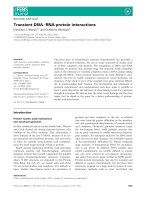Báo cáo khoa học: "News" docx
Bạn đang xem bản rút gọn của tài liệu. Xem và tải ngay bản đầy đủ của tài liệu tại đây (83.04 KB, 2 trang )
[
Mechanical Translation
vol.5 no.2, November 1958; pp.49-50]
N
ews
The following report was received from Prof.
Ichiro Honda of the Department of Psychology
at Kyoto University in Kyoto, Japan. The trans-
lation has been authorized by staff members of
the Institute of which Prof. Honda is a member.
Since finishing electronic computers ETL-
Mark III and IV last fall, we have been working
on the English-to-Japanese electronic transla-
tor and reader for English, and we have just
completed pilot models of both machines. With
these machines, sentences typewritten in Eng-
lish are automatically translated into Japanese.
The machine is instructed to translate English
into Japanese in the following manner.
1.
For each English sentence, one Japanese
sentence is processed. (Sentence-for-sentence
translation.)
2.
After each word of a sentence has been
identified in the dictionary, a decision is made
about the part of speech of the word.
3.
Suffixes such as -s denoting plural and -ed
denoting past are handled according to suffix-
processing orders.
4.
We do not work out a corresponding Japa-
nese word directly from an English word, con-
sidering required rearrangement of word order.
5.
Because there are four kinds of sentences,
declarative, interrogative, exclamatory, and
imperative and because there are many types
of declarative sentences, sentence types and
sentence patterns must be identified. This
process is called "classification of sentence
patterns."
6.
To identify the sentence pattern, the sub-
ject, verb, object and complements must be
sorted out. The logical process is carried on
until the fundamental structure of the sentence
conforms to any one of the following five funda-
mental sentence patterns, setting aside modi-
fiers consisting of unneeded words and phrases
such as the adjective preceding the noun and the
prepositional phrase following the noun.
I.
S-ga V-suru.
Kare-ga Benkyo-suru.
(He studies.)
H.
S-ga V-da C.
Kare-ga da Gakusei.
(He is a student.)
III.
S-ga Vt-suru O-o.
Kare-ga Ai-suru Musume-o.
(He loves a girl.)
IV.
S-ga Vt-suru IO-ni DO-o.
Kare-ga Hasso-suru Ototo-ni Kozut-
sumi-o.
(He sends a parcel to the brother.)
V.
S-ga Vt-suru O-o C-ni.
Karera-ga Senkyo-suru Kare-o
Shicho-ni.
(They vote him major.)
7.
When it happens that there is more than one
part of speech for a word, the first part of
speech is tested. If the pattern of the sentence
cannot be identified, we proceed to the second.
There is only one corresponding Japanese word
for each part of the English word. For example,
kono for 'this' (adj.) and kore for 'this' (pro.).
8.
After the pattern has been identified, ga. is
added to the subject, -o to the object, and -ni
to the complement; the verb is moved to the end
of the sentence; and a roughly corresponding
Japanese sentence is constructed.
9.
The "near sentence* mentioned above is
supplemented with pre-excluded modifiers and
all words of the original English sentence are
inserted. In prepositional phrases the noun is
placed before the preposition.
10.
Each English word is replaced by the cor-
responding inflected Japanese word.
11.
The Japanese sentence is written entirely
in 'Katakana' and a space is left between words
as in the English sentence, except the 'Kaku-
joshis' of -ga, -ni, and -o.
12.
A word not stored in the memory is process-
ed as a noun and typewritten just as it was in
English.
13.
Because 'Kanji' is not used, 'On' phonetic
reading is limited to a minimum in the Japanese
sentence produced, and 'Yamato-Koto-ba" (tra-
ditional Japanese not derived from Chinese) is
preferred, for example, saiwai for kofuku and
sare for kanojo.
14.
For the time being, sentences containing a
relative pronoun are not handled in our program,
Outline of the Apparatus.
1.
Input: It reads 73 letters, including the capi-
tals, lower case letters, comma, question mark,
etc A letter consists of 8 bits (units).
2.
Output: 75 letters of 'kana' (dakuten, han-
dakuten, and soukon), and the capitals of the Ro-
man alphabet, etc. 8 bits per letter.
3.
Letters inside the apparatus: After being re-
ferred to the "dictionary" all letters are repre-
sented by word numbers, thereby avoiding in-
convenient processing of English words of vary-
ing lengths such as very short ones (I, is) and
much longer ones (dictionary, representative,
etc.). This representation is used until just be-
fore the Japanese translation.
4.
Memory: We installed
a.
magnetic drum con-
taining 820, 000 bits of information on English
grammar, parts of speech, idioms, translation
of each word, Japanese grammar, etc. . The in-
formation is arranged in 200 columns. Besides
these 200 columns, there are 10 extra columns
for the various translation operations, and each
word can be processed at the speed of 1ms.
5.
Outline of the main apparatus (translator):
It looks very much like the electronic computer
and consists of about 650 packaged circuits pat-
terned after the ETL-Mark IV electronic compu-
ter. There are 46 orders for the operations
inside the machine.









